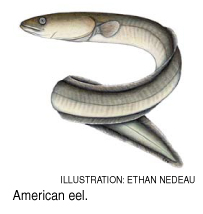From the Scientific Literature
Eel declines linked to changes in Sargasso Sea
 American eels are quickly disappearing from restaurant menus as stocks have declined sharply across the North Atlantic. The reasons for the eel decline remain as mysterious as its long migrations. A recent study by a National Oceanic and Atmospheric Administration (NOAA) scientist and colleagues in Japan and the United Kingdom says shifts in ocean-atmosphere conditions may be a primary factor in declining reproduction and survival rates. American eels are quickly disappearing from restaurant menus as stocks have declined sharply across the North Atlantic. The reasons for the eel decline remain as mysterious as its long migrations. A recent study by a National Oceanic and Atmospheric Administration (NOAA) scientist and colleagues in Japan and the United Kingdom says shifts in ocean-atmosphere conditions may be a primary factor in declining reproduction and survival rates.
“Although many aspects of spawning and early life history of this species are poorly understood, they are clearly adapted to grow in the low productivity waters of the Sargasso Sea south of Bermuda,” NOAA biologist Kevin Friedland said in a statement. “They spend up to a year or more as larvae and tend to live in the upper 100 meters (about 330 feet) of the water column, so any changes in the surface waters will have a big impact during critical stages in their development.”
Friedland and colleagues have found a significant correlation between the North Atlantic Oscillation (NAO), a decadal long ocean-atmosphere circulation pattern, and long-term variations in the catches of juvenile stages of the eels, commonly called glass eels. The harvest of glass eels, considered a delicacy, remains controversial due to concerns about stocks that some say may be close to collapse.
Their study was published recently in the ICES Journal of Marine Research. [more information]
[ back to top ]
*Web only content*
Mysterious minerals in ocean sediments linked to diatoms
Polyphosphate from diatoms, a major group of marine algae, may provide the building blocks for a mysterious group of minerals found in ocean sediments. Deposits of apatite, the most common type of calcium phosphate, lock up significant amounts of phosphorus in the ocean, regulating the availability of an important nutrient at the bottom of the world’s food chain. Researchers have been puzzled about the formation and distribution of these ocean apatites, since organic phosphates do not precipitate easily in ocean sediments. Researcher Julia Diaz at the Georgia Institute of Technology in Atlanta, Georgia, and her colleagues show in a paper in the May 2 issue of Science magazine that polyphosphate-containing diatoms may provide a major source of phosphates to seed these formations. The findings also suggest that changes in the abundance of diatoms over geologic time could have had a substantial effect on paleoclimate (climate change looked at from the entire Earth’s history) by regulating the amount of phosphorus available for plant production and indirectly affecting atmospheric carbon dioxide levels.
“Marine Polyphosphate: A Key Player in Geologic Phosphorus Sequestration," by J. Diaz and E. Ingall at Georgia Institute of Technology in Atlanta, GA; C. Benitez-Nelson at University of South Carolina in Columbia, SC; D. Paterson, M.D. de Jonge, and I. McNulty at Argonne National Laboratory in Argonne, IL; D. Paterson and M.D. de Jonge at Australian Synchrotron in Clayton, VIC, Australia; and J.A. Brandes at Skidaway Institute of Oceanography in Savannah, GA, Science, May 2, 2008, Vol. 320, pp. 652-655.
[ back to top ]
*Web only content*
Mass spawning and coral reef
Researchers studying the effects of mass spawning near coral reefs have observed a cascade of processes in the reefs during the days following these spawning events. A “Perspective” piece in the May 2 issue of Science magazine discusses how reef ecosystems respond to sudden increases in nutrient loads and process the organic matter produced from coral spawning. The mass spawning events can stimulate biological activity at the sea floor and in the water column, but on rare occasions they have also led to mass mortalities because of extremely large reductions in oxygen concentrations. Researcher James Guest of Newcastle University in the United Kingdom explains the importance of examining coral reefs' responses to large nutrient addition on an ecosystem scale and notes the many factors involved in this relationship, including the highly permeable reef sands and bacterial organisms that act as filters to buffer extreme nutrient peaks. These findings are important when comparing reef ecosystems under different levels of stress, and they provide greater insight into coral reef functioning and resilience.
"How Reefs Respond to Mass Coral Spawning," by J. Guest at Newcastle University in Newcastle upon Tyne, UK, Science, May 2, 2008, Vol. 320, pp. 621-623.
[ back to top ]
|








